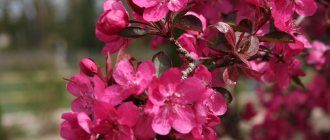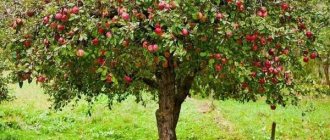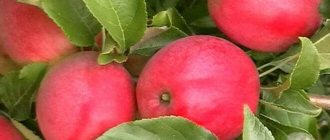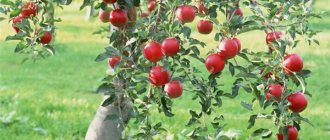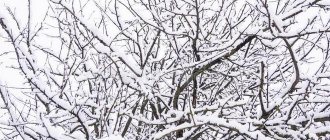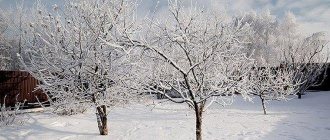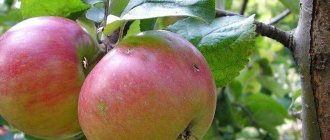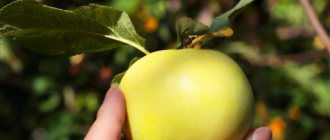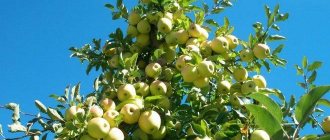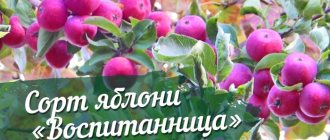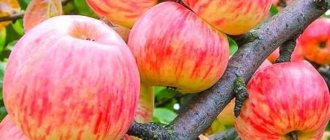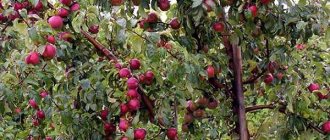Characteristics of the variety
The Arkadik apple variety is very stable and surprisingly viable. It grows quickly if planted and cared for correctly. The harvest is large and plentiful; it is often used for making dried fruit, juice and jam.
Mature tree height and crown width
The apple tree can reach 10 meters in height. The crown is wide, the branches are spreading, but sparse. There are many shoots, ringlets are formed on them, on which fruits are subsequently set. The leaves are elongated, ovate, bright green, matte structure, smooth, slightly pointed at the tip.
Mature trees of this variety.
Advantages and disadvantages
The apple tree was created specifically for selection in the middle zone and has a number of positive characteristics. Among them:
- a large amount of harvest;
- fast growth rate;
- delicious fruits;
- long flowering period;
- disease resistance;
- low maintenance requirements.
The apple tree has a drawback, which can more be called a negative trait. Fruits fall off if they are not picked in a timely manner, and the shelf life of the fruits is relatively short. Although these are typical indicators for summer varieties.
Tasting assessment
On the tasting scale, the fruit received a mark of 4.2 points. The pulp is soft, slightly oily. The fruits have a very pleasant aroma, fresh and bright. The taste of apples is dessert, harmoniously sweet and sour, although the sweetness noticeably predominates.
Productivity
The maximum amount of harvest that was recorded was 340 kg of fruit from one apple tree. But the usual figure is about 250 kg, and a fairly large harvest can be harvested in the fourth year after planting. The fruits themselves are also quite large, weighing about 200 grams. On an industrial scale, the average harvest amount was 300 centners per hectare.
Apple harvest.
Winter hardiness
The Arkadik variety's resistance to low temperatures is at the highest level. It easily tolerates frosts down to -35 degrees, recurrent frosts and periodic thaws. After any, even the harshest winter, the apple tree will begin its full development in the spring.
But Arkadika has a slightly different attitude towards drought. Of course, the variety is able to withstand extreme conditions and lack of moisture for a long period. But this will significantly affect the number of fruits.
Resistance to scab and other diseases
Arkadik shows a high level of scab and other fungal diseases. The variety is quite resistant to various types of pests. But such an indicator is not a panacea. It is always important to remember about prevention and agricultural technology.
Self-fertility and pollinating varieties
According to its properties, the apple tree is considered self-fertile. This is very good and convenient, because in situations where there is no pollinator nearby, there is nowhere to plant it, or the weather conditions are not very favorable, ovaries will still appear on the apple tree.
But planting a tree nearby on your own or a neighboring plot that will serve as a pollinator is preferable. In this case, the amount of harvest will be greater, even doubled. Any varieties that bloom at the same time are suitable for cross-pollination. It would be nice if they were similar in characteristics and taste.
Advantages and disadvantages
The obvious advantages of the Arkadik variety include:
- begins to bear fruit early (at the 3rd year of life);
- early ripening;
- stable and high productivity;
- excellent taste of the fruit;
- ease of care;
- resistance to major diseases and pests;
- frost resistance.
One of the negative characteristics is that ripe apples quickly fall off the tree and are stored fresh for no more than one and a half months.
To create the Arkadik variety, breeder V.V. Kichin had to work hard, but the result was an excellent summer apple variety. The benefits of the variety are appreciated by residents of all regions of the country and, without much hassle, they receive annual rich harvests of excellent-tasting fruits.
Planting and care
There will be no difficulties or special manipulations during planting. There will be several features in agricultural technology that are worth considering. First you need to choose a landing site. It should be in the sun and protected from the wind. It is important to consider the size of the crown and root system. It is very wide and spreading, as is the root system. Therefore, you need to provide her with plenty of space.
Proper planting of an apple tree.
Timing and correct method of planting
The apple tree can be planted in spring or autumn. It is necessary to focus on the climatic features of the area in which the apple tree will be cultivated. In spring, this period usually occurs at the end of April, when the soil has already warmed up well. In autumn, the fruit crop is placed in the ground at the end of September.
Conventional planting technology:
- The pit for planting is prepared in advance; nutritious soil and fertilizers are added to it.
- If necessary, make drainage at the bottom.
- A peg is driven in the middle and a seedling is placed against it.
- The roots are carefully straightened and covered with soil.
- After planting, water.
It is important to ensure that the neck of the root is not deepened.
Agricultural technology
Caring for an apple tree is not difficult, it is not capricious and develops fully. There are a number of important events that are held year after year.
These include:
- sanitary and formative trimmings;
- clearing the tree trunk circle of weeds, loosening it and mulching it;
- watering 4-5 times during the season, but depending on climatic conditions the schedule will be adjusted;
- spring preventive spraying;
- Fertilizers throughout the season will also help to fully grow and bear fruit abundantly.
Although the variety is considered resistant to low temperatures, it is better to protect the young tree from low temperatures. To do this, you need to apply fertilizer to the tree trunk circle in the fall, insulate the tree trunk circle and cover the trunk.
Caring for Arkadik trees
Watering
An apple tree, like any cultivated plant, needs proper watering for normal functioning. In the first year of life, a young tree needs to be watered about 2 times a month. Water consumption for two to three year old trees is 5-6 liters.
In mature trees, the amount of moisture received directly affects the size and juiciness of the fruit. Therefore, in an early and dry spring, the first watering should be carried out in May, even before flowering begins.
The irrigation area is calculated according to the size of the tree. It is generally accepted that the root system of an apple tree is approximately equal to the width of its crown. That is, what is the diameter of the tree crown, so is the irrigation area. It is this area that is watered at the rate of 5 buckets per square meter. If the soil is dry, then the norm is increased to 6-7 buckets of water.
If spring weather helps retain soil moisture after the winter season, then the first watering is carried out later, during the active flowering of the tree. During the period when the apples have set and begun to grow in mass, the apple tree requires a large amount of moisture; it is at this time that it is watered a second time. In dry years, an additional third watering is carried out in order to prepare the apple tree for the winter period. It is important to take into account the amount of natural precipitation. So, in the usual cool and rainy autumn, additional moisture will only harm the plant.
The amount of water is calculated similarly for all seasons. Watering can be done with unsettled water from a well or well. Cold water will not harm the apple tree if it does not get on the branches and leaves. The best time for this procedure is the evening or morning hours, when the sun is not active. Watering can be done in three ways:
Surface watering
A furrow 10-15 cm deep is dug approximately along the diameter of the crown, but it is important not to damage the roots of the tree. Watering is carried out gradually, in small portions directly into this irrigation groove.
Drip irrigation
This method is widely used in industrial apple orchards and is very effective, since water flows evenly to the root system of the tree.
Sprinkling
Various types of sprinklers are used for this method. It is important that the water disperses finely and evenly.
Important! You should not pour water under a tree trunk; the apple tree drinks not from the trunk, but from its widely spread root system.
Tree pruning
The first formative pruning is carried out a year after planting the apple tree. This should be done in February or March, while the plant is dormant and sap flow processes have not yet begun. It is important to choose a period so that the air temperature does not drop below 10-12 degrees below zero. The purpose of this pruning is the correct formation of the tree crown. Therefore, branches growing overlapping, directed downwards or towards the tree trunk are removed. Inconveniently located branches are also trimmed and the top of the apple tree is shortened.
In the fall, after all the foliage has fallen, sanitary pruning is carried out. To do this, remove dried branches and branches affected by diseases and pests. Such plant residues are burned or taken outside the site, and the instrument is thoroughly disinfected.
The crown is actively formed in the first 2-3 years after planting the apple tree, since during this period of time the tree grows very quickly. Then, when the fruiting period begins, growth stops and at this time the process of severe pruning of branches is stopped. You just need to maintain the crown of living and healthy branches, that is, periodically remove dried, diseased and rotten ones.
Feeding
In the first year, apple trees do not need additional feeding; what was added to the soil during planting is enough for them. Starting from the second year, fertilizing is a mandatory agrotechnical practice, as the tree is actively growing and gaining strength to begin bearing fruit.
In the spring, as soon as the snow has melted, Arkadik is fed with urea. To do this, 500 grams of the substance are scattered over the diameter of the tree trunk circle.
Complex mineral fertilizer applied at the beginning of flowering will give the apple tree the strength to produce fruit and will be the key to a bountiful harvest.
During the period when the fruits are actively filling, the tree is fed with any organic composition, for example, mullein infusion or a fermented herbal cocktail.
In order for the apple tree to winter well after harvesting, the last fertilizing of the season is carried out. The tree trunk circle is cleared of plant residues, dug up and at the same time superphosphate, potassium sulfate (300 grams of each) and 2 buckets of humus are added to the soil.
Protection from diseases and pests
"Arkadik" is resistant to fungal diseases such as scab. This is a very big plus of the variety, since this fungus is very characteristic of apple crops. Scab is very insidious and difficult to cure; it causes irreparable damage to the fruit tree.
In order to protect Arkadik from pest attacks, it will be enough to carry out annual treatment with copper sulfate. The procedure is carried out in early spring, before the buds appear.
Preparing for the winter season
The Arkadik apple tree tolerates winter frosts well, and therefore does not require the construction of capital winter shelters. To prepare for winter, it will be sufficient to carry out the planned autumn work, which was mentioned earlier: sanitary pruning of the crown, cleaning and digging up the tree trunk, applying fertilizers and watering if necessary.
Additionally, the trunks of young apple trees are painted with chalk solution, and trees older than three years with lime. This will save Arkadik from February sunburn.
Subspecies and options
There are a number of subspecies that can be grown.
On a dwarf rootstock
The dwarf subspecies is more resistant to low temperatures than a regular tree. Its height usually does not exceed 2.5 meters.
Dwarf apple tree.
Columnar
The columnar apple tree Arkadik is no different from the regular variety, except for the size of the crown. The tree is very compact, the trunk is round. When caring for such an apple tree, you need to pay attention to additional protection from low temperatures.
Columnar apple trees.
Summer yellow
This subspecies of Arkadika is practically no different in properties from the parent culture. Only the color and size of the fruits have changed: they are smaller and yellower in color. It is important to consider that the summer yellow Arkadik can be affected by scab and will need to be additionally covered.
Apple tree Arkadik Yellow.
Sugar
A productive subspecies with very large fruits. The fruits are beautiful, regular in shape, sweet. At the same time, the yield and properties are the same as those of a regular Arkadik.
Sugar Arkadik.
Pink
A subspecies that is completely different from the mother variety. The apple tree is small, compact and neat. The fruits are small, yellow-pink, there are very few of them.
Apple tree variety Arkadik Pink.
Features of planting the Arkadik apple tree
To grow a strong tree, it is necessary to create optimal conditions for its growth. It is necessary to choose the right area for planting, where the plant can take root well. The place should be well lit, without drafts. The soil on which apple trees are grown can be any, because the plant is unpretentious. The groundwater level must be at least 1.5 m so that there is no risk of flooding of the rhizome.
We recommend that you familiarize yourself with the summer varieties of apple trees:
Features of cultivation in different regions
The technical characteristics and properties of the apple tree allow it to be grown in different regions. The features of cultivation and care will differ slightly.
Moscow region
Apple trees are easy to grow in the Moscow region. It is only important to monitor the condition of the soil: if it is acidic, you will need to add lime.
Middle lane
The middle zone is ideal for growing Arkadik. All the features of growth are the same as in other regions. The variety grows fully and bears fruit without any difficulties.
Siberia
Apple trees in Siberia can be grown under some kind of shelter. The trunk will need to be insulated and whitewashed. The tree should be planted in the fall to prevent it from starting to develop in cold conditions. But it is better to pay attention to the dwarf rootstock.
Ural
Although the climate of this region is more flexible than Siberia, very sharp temperature changes occur in both spring and winter. The resistance of the variety is sufficient, but not the highest.
How to properly care
To get a harvest, you need to water the plant correctly. The apple tree requires systematic watering. The variety is resistant to drought, but it does not have the ability of succulents to store moisture, so its lack affects the ovary, and later on fruiting.
Choosing the best watering
There are several types of watering for fruit crops
Surface
This method involves watering through channels and longitudinal furrows around the plants. Suitable for gardens where strict tree planting is used.
Drip
This is a specially created system that provides moisture access directly to the root of a particular plant.
Reviews
Anna Vladimirovna. Saratov. Not a bad variety, tasty apples and I don’t have any special problems with care. There are a lot of apples, all even, beautiful, large as one. And it’s nice to eat and there’s no shame in treating friends. The tree is again large, spreading, and looks wonderful on my large plot! There are no problems with diseases, and no bugs have appeared either. I recommend it to lovers of fresh, sweet, juicy apples.
Igor. Apatity. I don't really like these apples. Very sweet and cannot be stored. But in fairness, I can say that the smell is excellent! It’s inconvenient to pick - you’re a little late - and they themselves fall and get damaged. Although, maybe it will suit someone. But I prefer ones that are more sour and that last longer. These last barely a month.
More on Tele4n.Net:
How to propagate an apple tree: the best and most promising methods of propagation
Lyubov Mikhailovna. Krasnoyarsk Last year I planted an Arkadika seedling on the advice of a neighbor at the dacha; he has extensive experience in fruit growing. I recommended this variety specifically for a large family - so that everyone can eat plenty of fresh apples and not have any special problems in caring for them. So far I'm happy.
It grows very quickly and is not much of a hassle. It endured the winter well, did not freeze, and the roots did not freeze. I'll be waiting for the first harvest! I looked through a bunch of articles before settling on this variety. I wanted a big apple tree - the place was empty, and I didn’t want to plant anything.
Features of culture
The apple tree is quite large in size and grows quickly, and is also characterized by increased vitality. The characteristic traits of the variety actively manifest themselves on ordinary and dwarf rootstocks. The description of the beginning of the fruiting period, which occurs in the third year of life, shows that with the formation of fruits the tree noticeably slows down in development.
Compactly located thickened and bare reddish branches form a rounded-conical crown. The leaves are medium-sized, natural green in color, ovoid-oval in shape. The surface of the sheet plate is matte. Arkadik is a self-fertile, early-ripening variety that bears fruit on multiple ringlets.
The tree is distinguished by regular fruiting and in adulthood can produce over two hundred kilograms per year. The apples are large and evenly oval in shape. At the beginning of formation, the fruits are green, but as they ripen, the apples gain a rich red blush, which lies in stripes on a large surface of the skin. The fruit pulp has a medium-hard texture.
The fruits of the Arkadik variety have a sweet taste with slight notes of sourness
The description of the taste boils down to the fact that the fruits have pronounced juiciness, sweetness and tartness with a barely noticeable sourness. Apples reach harvest and consumer ripeness almost simultaneously - in August, but are stored for no longer than a month. The apple tree tolerates harsh winters well and is not susceptible to scab.
The goal of breeding the Arkadik variety was to obtain a variety that would not be susceptible to scab infection, resistant to low temperatures and retain its taste.
Arkadik has become not only a frost-resistant variety, but also received a high rating according to this classification. It has the ability to withstand frosts down to -35 °C, while maintaining all its qualities.
Scab is a fungal disease that can affect any plant and damage a significant part of the crop. Selection manipulations made Arkadik stable:
- to scab;
- to other fungal diseases;
- to the harmful spread of insects.
The variety was created for the regions of central Russia. This area is known for the sharp drop in temperatures at night during the autumn period of the year. It is suitable for planting in the far Moscow region. It is successfully grown in the southern regions of central Siberia.
Apple tree productivity
The variety has earned its popularity due to its high yield. Up to 220 kilograms of apples are harvested from one tree. The fruits are characterized by the following characteristics:
- weight reaches 310 grams;
- color – pink-red;
- thin skin;
- shape – semi-oval, oblong;
- taste – sweet and sour, with a shift towards sweet.
